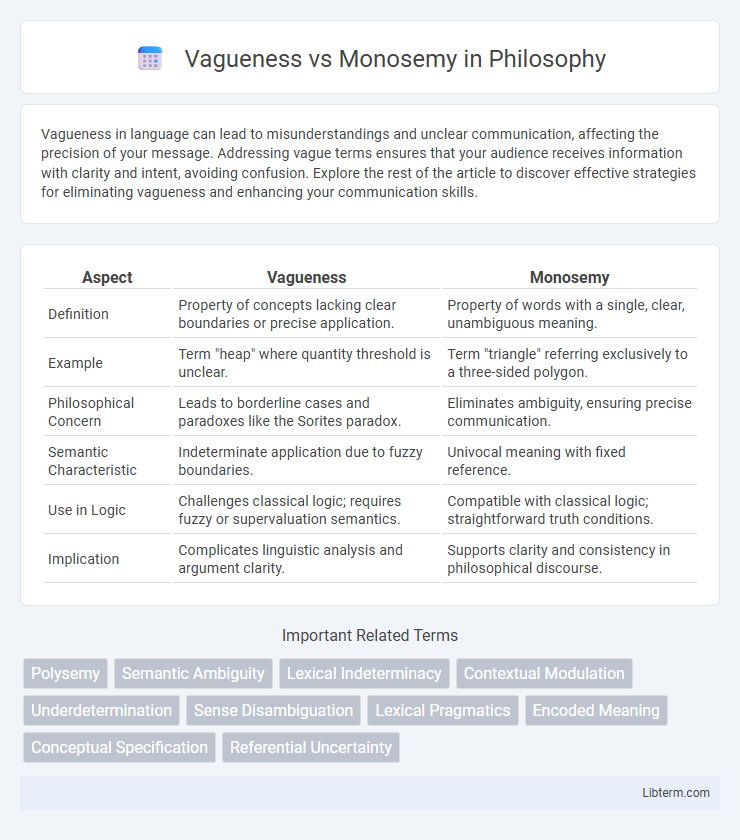Vagueness in language can lead to misunderstandings and unclear communication, affecting the precision of your message. Addressing vague terms ensures that your audience receives information with clarity and intent, avoiding confusion. Explore the rest of the article to discover effective strategies for eliminating vagueness and enhancing your communication skills.
Table of Comparison
| Aspect | Vagueness | Monosemy |
|---|---|---|
| Definition | Property of concepts lacking clear boundaries or precise application. | Property of words with a single, clear, unambiguous meaning. |
| Example | Term "heap" where quantity threshold is unclear. | Term "triangle" referring exclusively to a three-sided polygon. |
| Philosophical Concern | Leads to borderline cases and paradoxes like the Sorites paradox. | Eliminates ambiguity, ensuring precise communication. |
| Semantic Characteristic | Indeterminate application due to fuzzy boundaries. | Univocal meaning with fixed reference. |
| Use in Logic | Challenges classical logic; requires fuzzy or supervaluation semantics. | Compatible with classical logic; straightforward truth conditions. |
| Implication | Complicates linguistic analysis and argument clarity. | Supports clarity and consistency in philosophical discourse. |
Understanding Vagueness: A Semantic Overview
Vagueness occurs when a term lacks precise boundaries, leading to multiple interpretations in language, unlike monosemy where a word has a single clear meaning. Understanding vagueness involves analyzing context-dependent meanings and borderline cases that resist strict classification in semantics. This semantic flexibility challenges fixed definitions, requiring nuanced approaches in linguistic theory and natural language processing.
Defining Monosemy in Linguistics
Monosemy in linguistics refers to a word having a single, clear meaning without ambiguity or multiple interpretations, which contrasts with vagueness where meanings are imprecise or context-dependent. A monosemous term enables precise communication by reducing semantic confusion and enhancing clarity in language processing. This concept is crucial in computational linguistics and lexicography for developing accurate natural language understanding systems.
Key Differences Between Vagueness and Monosemy
Vagueness refers to the lack of precise boundaries or clarity in the meaning of a word, leading to multiple interpretations depending on context, while monosemy describes a word having a single, clear, and unambiguous meaning. Key differences include the semantic clarity where monosemy ensures exact understanding, whereas vagueness allows for flexible, context-dependent meanings. Vagueness often causes communication challenges due to ambiguity, whereas monosemy facilitates precise and effective communication.
The Role of Context in Vagueness
Vagueness occurs when a word or phrase lacks precise boundaries, making its interpretation highly dependent on context to clarify meaning. Monosemy involves words with a single, clear meaning that rarely requires contextual cues for understanding. Context plays a crucial role in vagueness by providing additional information that helps listeners or readers resolve ambiguity and arrive at the intended interpretation.
Monosemy and Unambiguous Communication
Monosemy ensures each word or phrase has a single, clear meaning, which significantly enhances unambiguous communication by eliminating multiple interpretations. This linguistic precision is crucial in technical writing, legal documents, and programming languages where clarity directly affects understanding and execution. Emphasizing monosemy reduces confusion and increases efficiency in conveying specific information across diverse contexts.
Real-World Examples of Vagueness
Vagueness occurs when a word or phrase lacks precise boundaries, leading to multiple interpretations depending on context, as seen in the term "heap," which has no clear cutoff for how many grains constitute it. Monosemy, in contrast, applies to words with a single, unambiguous meaning, such as "thermometer," which refers specifically to a device measuring temperature. Real-world examples of vagueness include terms like "tall," where the threshold varies between cultures and individuals, and "soon," which offers an indefinite timeframe open to interpretation.
Linguistic Advantages of Monosemy
Monosemy eliminates ambiguity by assigning a single, clear meaning to each word, enhancing precision and ease of interpretation in communication. This clarity benefits natural language processing and machine translation by reducing errors related to context-dependent meanings. Consequently, monosemy improves efficiency in language learning and comprehension, facilitating faster acquisition of vocabulary and minimizing misunderstandings.
Challenges Caused by Vagueness in Language
Vagueness in language creates significant challenges by introducing ambiguity and imprecision, making it difficult to interpret meaning consistently across different contexts. Unlike monosemy, where terms have a single, clear definition, vague expressions lead to multiple plausible interpretations, complicating communication and computational language processing. This ambiguity hinders automated text analysis, natural language understanding, and precise information retrieval.
Semantic Theories Addressing Vagueness and Monosemy
Semantic theories addressing vagueness and monosemy explore how meaning varies in language, distinguishing between words with singular meanings (monosemy) and those with indeterminate boundaries (vagueness). Prototype theory and degree semantics provide frameworks for modeling vagueness by interpreting gradations of meaning, while monosemy is supported by cognitive semantics emphasizing consistent denotations within fixed contexts. Formal semantics and context-dependent models together help reconcile these phenomena by offering structured yet flexible approaches to meaning representation.
Implications for Language Processing and AI
Vagueness in language introduces indeterminacy, posing challenges for AI in precise interpretation and meaning extraction, whereas monosemy offers clear, single-meaning terms that enhance computational efficiency and accuracy in natural language processing. AI systems must incorporate context-aware algorithms and probabilistic models to handle vague expressions effectively, ensuring nuanced understanding and response generation. Leveraging monosemy simplifies semantic parsing, reduces ambiguity, and improves machine learning outcomes in tasks like sentiment analysis and machine translation.
Vagueness Infographic

 libterm.com
libterm.com